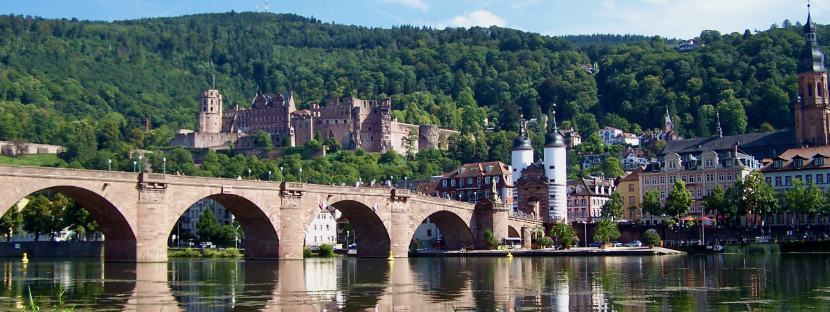
Heidelberg Events
Heidelberg Christmas Market
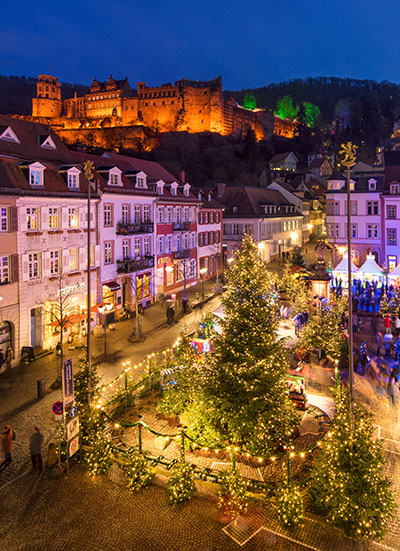 One of the attractions at the Christmas Market: the romantic Winter Forest at Kornmarkt © Heidelberg Marketing, photo by Tobias Schwerdt
One of the attractions at the Christmas Market: the romantic Winter Forest at Kornmarkt © Heidelberg Marketing, photo by Tobias Schwerdt
When the Christmas Market opens its gates on 24 November 2025, Heidelberg will shine warmly under thousands of lights. The scent of roasted almonds, gingerbread, and mulled wine fills the streets, and the old town transforms into a festive winter wonderland.
Beloved attractions await in the squares: the impressive Heidelberg Barrel at the Market Square, the carousel with its revolving rocking horses that has been enchanting visitors for almost four decades, the radiant Christmas pyramid at University Square, the romantic Winter Forest at Kornmarkt, and the enchanting ice rink at Karlsplatz.
A special tip: Every Saturday in Advent at 4:30 pm, guided tours lead through the Christmas Market, introducing visitors to the traditions of the Advent season – accompanied by a warming cup of mulled wine or punch.
The Christmas Market ends on 22 December 2025, the Winter Forest remains open until 1 January 2026, and the ice rink even until 11 January 2026.
Enjoy Jazz Festival 2025
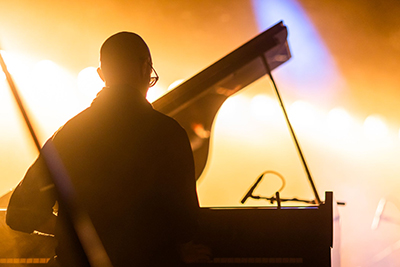 Nik Bärtsch at Enjoy Jazz 2025 © Photo Christian Gaier
Nik Bärtsch at Enjoy Jazz 2025 © Photo Christian Gaier
With Enjoy Jazz, Germany’s largest jazz festival takes place every year in Heidelberg, Mannheim, and Ludwigshafen.
For the 27th edition of Enjoy Jazz, from 2 October – 8 November 2025, numerous world stars and promising young talents will once again be guests in the Rhine-Neckar metropolitan region.
Highlights in Heidelberg include performances by American harpist Brandee Younger, Swiss pianist Nik Bärtsch, American saxophonist James Brandon Lewis, Austrian electro pioneers Kruder & Dorfmeister, as well as the European premiere of a Jazz Is Dead night featuring American artists Adrian Younge and Bilal together with saxophone legend Gary Bartz.
WinterVarieté Heidelberg Celebrates Its Anniversary
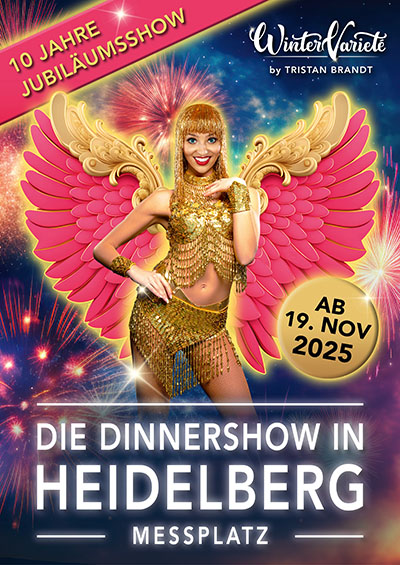 For ten years, the WinterVarieté has been enchanting its audiences
For ten years, the WinterVarieté has been enchanting its audiences
Starting 19 November 2025, the spectacular Heidelberg ShowArena once again opens its doors on the Heidelberg Fairground for unforgettable hours full of entertainment and indulgence. In the 2025/26 season, the region’s most modern dinner show celebrates its 10thanniversary – a decade of magic, culinary delights, and enthusiastic audiences.
A brand-new variety show featuring international artists is ready to captivate the audience with a perfect blend of state-of-the-art stage technology, dance, acrobatics, comedy, and magic.
The performance is accompanied by an exquisite three-course gourmet menu created by top chef Tristan Brandt. Guests can choose between a classic or vegetarian version, embarking on a culinary journey perfectly matched to the show experience.
The new Valerieweg footbridge
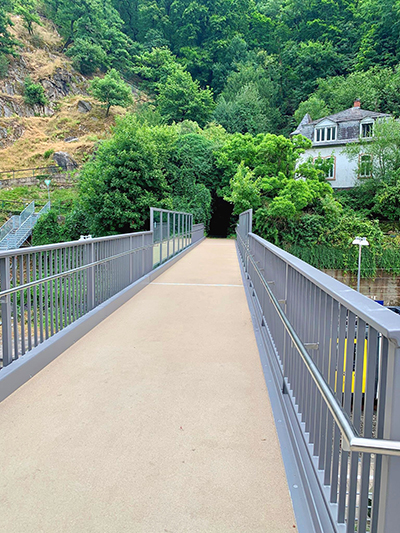 The newly reconstructed Valeriewegsteg in Heidelberg © Heidelberg Marketing, photo Eva Bruce
The newly reconstructed Valeriewegsteg in Heidelberg © Heidelberg Marketing, photo Eva Bruce
After extensive construction work, the Valeriewegsteg near the historic Altes Karlstorbahnhof in Heidelberg’s Old Town has been completely rebuilt and is now open to the public.
This pedestrian bridge, which connects Heidelberg’s Old Town railway station with the Valerieweg and the Königstuhl hill, has been reconstructed to match the original. It now shines in new splendor and stands as a successful example of how tradition and modern infrastructure blend into Heidelberg’s cityscape.
Crossing the bridge takes visitors onto the Valerieweg, following in the footsteps of Valerie, daughter of Austrian Empress Elisabeth (“Sissi”). The path winds its way past rugged granite cliffs, leading uphill to the Schloss-Wolfsbrunnenweg, where it meets the Elisabethenweg.
Empress Elisabeth and her daughter Valerie visited Heidelberg several times for extended stays between 1883 and 1890.
Did you know …
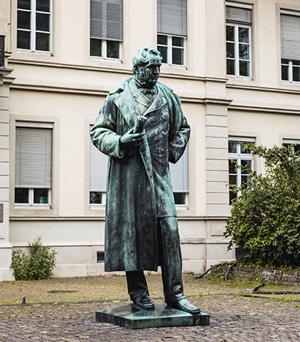
… that the Bunsen burner was invented in Heidelberg?
Robert Wilhelm Eberhard Bunsen, born on March 30, 1811 in Göttingen, died on August 16, 1899 in Heidelberg, was a German chemist. Together with Gustav Robert Kirchhoff, he discovered caesium and rubidium in 1861 and developed spectral analysis, which can be used to detect chemical elements in a highly specific manner. For this purpose, Bunsen perfected a particular gas torch, which had previously been invented by Michael Faraday and would later be called the Bunsen burner. During his time at the University of Heidelberg, Bunsen taught well over 3,000 students. In his honor, a statue was erected in the anatomy garden.
You can even take a Bunsen tour of Heidelberg.
One of his students was the chemist Henry Roscoe. About Robert Bunsen, he said: “As an investigator, he was great. As a teacher, even greater. As a man and friend, he was greatest.”
Did you know …
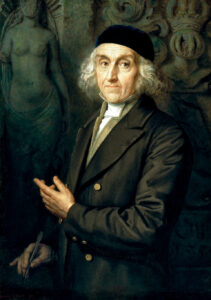
Charles Francois de Graimberg (1774 – 1864) in a portrait by Guido Schmitt, 1902 © Kurpfälzisches Museum Heidelberg
… that a Frenchman, Charles de Graimberg, saved the Heidelberg Castle ruins?
Charles de Graimberg came to Heidelberg in 1810 to make copperplate engravings of the castle ruins and the town – and remained in Heidelberg until his death in 1864. Back then, he was shocked to discover that the people of Heidelberg were using the ruins as a quarry for their houses and the castle garden as a potato field. Furthermore, a contract had already been signed with a demolition company.
He campaigned for the preservation of the ruins with personal commitment and his own money, paid guards, even took up residence in the castle and his copperplate engravings made Heidelberg known to a broad public. He was successful.
And so, thanks to Charles de Graimberg, we can still marvel at this world-famous symbol of Romanticism today.
Did you know …

The Heidelberg Town Hall carillon was inaugurated in 1961 © City of Heidelberg
… that Heidelberg’s Town Hall has its own carillon?
The carillon at Heidelberg’s Town Hall is one of the city’s most charming landmarks – a musical symbol and a living piece of local history. Made up of 26 finely cast bronze bells from the renowned Schilling Bell Foundry in Heidelberg, the carillon has been enchanting the Old Town for over 60 years with its distinctive sound.
It was officially inaugurated on 10 December 1961, and since then, it has played a three-minute melody three times a day – at 11:55 a.m., 3:55 p.m., and 6:55 p.m. With a selection of around 50 programmed tunes across five seasonal and thematic categories – summer, Advent, Christmas, „secular“, and a May programme – the carillon is a musical companion throughout the year.
The largest bell weighs 60 kilograms and lays the foundation for the melodies, while the full set of bells together weighs a solid 800 kilograms.
Did you know …

The founding document of Heidelberg University from 1386 © Photo by Steffen Schmid
… that the founding document of Heidelberg University is still preserved?
Prince Elector Rupert I founded Heidelberg University in 1386. He established it with papal approval in his residence city. The founding rector was the Dutchman Marsilius von Inghen, who came to Heidelberg from the University of Paris.
It is now the oldest university in Germany and, at the time, was the third university in the Holy Roman Empire, after Prague and Vienna – but unlike the other two, it was already a full university with faculties of medicine, law, theology, and philosophy.
The founding document, dated October 01, 1386, specified that the new university should be organized after the model of Paris. It has been preserved to this day and is one of the treasures of the University of Heidelberg’s archive.
Did you know …
… that Heidelberg is the most sustainable city in Germany?
The latest city ranking by business magazine WirtschaftsWoche concludes that Heidelberg is the most sustainable and future-oriented city in Germany.
Among other things, Heidelberg impresses with its passive house district Bahnstadt, the new energy storage facility in Pfaffengrund and the lowest youth unemployment rate.
Furthermore, the ranking highlights the high value that science and research, education and training have for Heidelberg. Every fifth euro in the city’s budget is invested for the benefit of children and young people, and around 70% of employees in Heidelberg work in knowledge-intensive services.